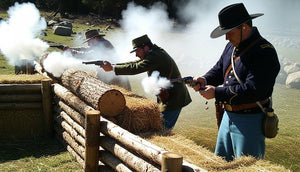Your stance can make or break your shot. But what’s the best handgun shooting stance? It all depends on the situation.
Unlike other “stance 101” posts floating around online, this guide goes beyond the bare minimum. We’ll go deeper than just naming stances or listing techniques. Here we’ll break down what makes each shooting stance work, what they are best for, and how you can adjust your body mechanics to suit your style, not someone else’s checklist.
We’ll also cover gear upgrades that give you an edge when accuracy, speed, and recoil management matter most.
Whether you’re new to pistols or looking to tighten your groups, let’s refine what keeps your shooting stance’s aim steady.
Why Your Shooting Stance Matters

When your stance is off, everything else falls out of place. Your accuracy suffers. Recoil throws you off balance. Even your grip starts to slip.
Your shooting stance is the foundation of every shot. Flinching, limp wristing, inconsistent groupings, and many other common shooting mistakes often come from poor lower-body mechanics.
A solid shooting stance helps you:
-
Absorb recoil more efficiently
-
Maintain accuracy during rapid fire
-
React quickly without losing control
-
Build repeatable muscle memory under pressure
So as you can see, this isn’t about looking cool. A proper handgun shooting stance leads to tighter groupings, better control, and more consistent results under pressure.
The Three Most Common Handgun Shooting Stances
Let’s start with the basic stances that all shooters must learn to dominate. We have already gone through some of these on our guide about how to improve accuracy when shooting pistols.
Isosceles Stance
You face your target square on, with your feet shoulder-width apart. Arms extend forward to form a triangle—hence the name. This is one of the most common and stable shooting stances for handguns.
The isosceles shooting stance works well under stress, is easy to learn, and helps keep your accuracy consistent when facing front. That’s why it’s often taught in beginner firearm training techniques.
But it does have trade-offs. The square position makes you less mobile, so in defensive situations, it exposes more of your body to the target. Still, it’s a solid choice for controlled environments, range days, and timed drills.
Weaver Stance
The Weaver stance puts one foot back, knees bent, and your upper body angled slightly toward the target. Your arms create a push-pull tension, as your strong hand pushes out while your support hand pulls back. It’s great to manage recoil and keep your shots on track.
The weaver shooting stance is a classic. It’s popular in law enforcement training, and it still works great for follow-up shots and pistol control.
But it’s not the easiest to learn. If you are new to shooting, the angled stance can feel awkward at first. Also, in close quarters, your support-side shoulder is a bit more exposed.
But once you get the feel for it, it’s a solid option for recoil management and tighter groups.
Modified Isosceles
This is the stance you’ll see most often at the range today. If you’ve been shooting for a while, chances are you’re already using the modified isosceles, even if you didn’t know it.
In the modified isosceles stance, you’re still mostly squared to the target, but your shoulders lean in and your weight shifts slightly forward. That’s why it feels natural when you’re moving, shooting fast, or running drills under time.
It blends the athletic forward lean of the Weaver with the solid base of the Isosceles. Stable and mobile. Simple as that.
Going Tactical: Advanced Shooting Stances That Actually Matter

Now that we have gone through the three basics, let’s level up. Here are three advanced shooting stances to gear up for anything.
Fighting Stance
This one is popular in defensive and law enforcement training. The fighting shooting stance mirrors a boxer’s posture: feet staggered, knees bent, hands up, and weight forward.
The fighting stance keeps your center of gravity low and lets you move fast. It’s not the most precise stance, but it does give you good mobility and balance in high-stress situations.
Speed Shooting Stance
This isn’t something you’ll find in a textbook. Competitive shooters develop the Speed Shooting Stance over time. It often looks like a wide stance, aggressive lean, and relaxed arms to reduce tension.
The speed shooting stance helps develop fast transitions and better split times. It’s all about efficiency: no wasted movements, just fast, accurate shooting.
If you want to train the speed shooting stance and run a Canik, we got the perfect gear for you: compensators. These allow faster follow-up shots with much less recoil, they offer a complete new shooting experience. So be sure to check out our top-tier comps at the 45 Blast store.
Kneeling or Prone Positions
When cover matters more than speed, switching to a kneeling or prone stance can save your life or your match score. We have covered the prone position in our post about long range shooting, but here is a reminder:
To do the prone shooting position, you lie flat on your stomach, legs extended behind you, and use both arms for stability. Your shooting hand holds the pistol, while your non-shooting hand supports either the grip or the ground in front of you.
Learning how to get low—and get back up smoothly—can make all the difference in dynamic drills.
Real-Life Mistakes That Sabotage Your Stance (And How to Fix Them)
You can memorize every stance in the book, but under stress, speed, or adrenaline, bad habits slip in fast. Whether you're a weekend range regular or someone preparing for competition or defense, here are the most common stance mistakes and how to correct them.
Locking the Knees
A locked knee might feel “stable,” but it turns your legs into stiff, unresponsive sticks. This reduces your ability to absorb recoil and shift weight fluidly.
Instead, keep your knees slightly bent. Think “athletic ready,” like a boxer or basketball player. You’re not frozen in place; you’re primed to move.
Shoulders Too Tense
Some shooters unconsciously hunch their shoulders when aiming, trying to “control” the gun by force. Tension leads to fatigue, poor recoil management, and awkward alignment.
So instead, try a relaxed, neutral shoulder position. This will help you to stay consistent, especially during repeated firing.
Over-Leaning or Leaning Back
Leaning forward is good, that’s true. But too much lean, especially at the waist, throws off your balance. And leaning back? That’s even worse. It shows you’re flinching, and it wrecks your stance.
How can you improve this in your shooting stance? Stay centered. Keep your chest over your toes and hips just behind. Athletic, not rigid.
Foot Placement That’s Too Narrow (or Too Wide)
Some shooters stand like they’re balancing on a tightrope. Others take a sumo wrestler approach. Neither helps.
Instead, focus on a shoulder-width stance. Standing like that gives you the sweet spot, enough room to anchor yourself without limiting mobility. Your lead foot can be slightly forward if needed, especially in dynamic shooting.
Inconsistent Handgun Presentation
Your draw, grip, and stance should all flow together. If you have to adjust your feet every time you present your handgun, you’re wasting time.
Your stance and grip should flow together. If you’re adjusting your stance after you draw, you’re wasting time and losing consistency. Train from the holster and focus on “presentation”. The fluid movement from holster to extension, with your stance naturally syncing in.
Choosing the Best Handgun Stance for You
There’s no one-size-fits-all answer. Your ideal shooting stance depends on your body type, firearm, training goals, and environment—whether that’s an indoor range or a close-quarters drill.
Want to improve your shooting stance? Here are two expert tips:
-
Ask a friend to record your shooting session. Watch how your body moves between shots. Do you reset your footing every time? Are your elbows rising too high? These small details can reveal big inefficiencies.
-
Test different stances under timed drills or simulated stress. Which one lets you move fast without losing accuracy? That’s your base. Build from there.
The Best Stance Is the One You Can Repeat Under Pressure
Shooters evolve. What matters is building a stance you can repeat when it counts—whether you're competing or in a real defensive scenario.
We all start with the basics, like the isosceles stance or the weaver. Then, as we progress, we train for more complex scenarios. Sometimes it’s for self-defense. Sometimes it’s just for kicks.
If you want better control and accuracy, now you know where to start. Upgrade your setup with competition-tested gear like our 45 Blast compensators. We designed them to reduce recoil and keep your groups tight—helping you get the most out of your shooting stance.
Train smart. Shoot sharp. And keep leveling up.


